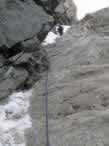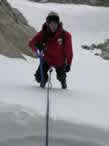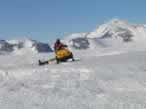Today was marked by a normal beginning, with a breakfast consisting of corn-beef hash (at least for myself) and raisin-filled brown bread. Once everyone had emerged and fed, we set off east across the ice towards Treves Butte with the intention of sampling a basalt dyke which vertically cross-cut the granite cliffs. Theoretically, a transect of exposure ages up this dike may reveal a rate with which the ice sheet lowered. The clinopyroxenes in the basalt would allow us to utilize small samples for analysis at Sujoy’s noble gas laboratory for quickly obtained, reliable exposure ages. Thus, these dykes cutting Treves Butte were ideal for the reconstructing previous ice elevations.
We took the snowmobiles to the edge of the ice-cored lateral moraine abutting the cliffs of Treves Butte, and discussed sampling strategy. I inspected one of the dykes, which required cramponing up a steep snow slope to the base of the first dyke of interest. The basalt cut through a very steep granite face, and differential weathering provided a narrow crack through which to climb and access the basalt at different points. It quickly became clear that this was not going to be as easy as it appeared from afar… What from a distance looked like quaint little cracks and jutting rocks to use for scrambling, turned out to be precipitous nearly vertical ledges and overhangs a bit closer up.
The group decision dictated that Peter and I would attempt to sample the dyke I had inspected, and Sujoy and Robert would sample another that was angled a bit more to the horizontal. I took a base elevation using the Trimble differential GPS, and calibrated the altimeter to that spot, as it wasn’t going to be possible to get elegant GPS points on the climb. Peter and I ascended the snow slope, and reached the basalt base where we took our first sample. The basalt proved to be a worthy adversary, as it took us the better part of an hour to wedge out a piece. Meanwhile, the wind began to blow fiercely around us, pushing a seemingly endless series of stratocumulus clouds across the sky towards the west.
Finally having finished taking the first sample, and its associated shielding correction, Peter and I ascended the narrow, nearly vertical gap between the granite and basalt. A thin strip of snow funneled into the gap required the use of crampon and ice-axe, as well as jutting basalt for holds and leverage. We kept trucking up this incredibly steep crack in the rock, until I realized Peter was almost suspended directly above me. I declined to look down at this point, afraid it would make me a bit weak in the knees to see how far down the drop was. Trusting the crampons and ice-axe, with no rope attached, had me sweating a bit… But perhaps the nervousness causing the adrenaline to surge was a good thing, as my hands, with only glove-liners on for increased finger agility, did not get cold amid the wailing Antarctic winds.
The next task was overcoming a lip of snow exceeding the vertical. I reluctantly placed all of my trust in the tools, and made it over. Overcoming the lip also entailed some fears that have always resulted in my shying away from rock-climbing. About time those pesky fears were driven away.
Once above the lip, I climbed, still trusting my footing which at this point was merely the toes of my crampons scratching rock through a light snow cover. I reached for a basalt ledge, and finally had something solid to hold onto. I dug footholds into a small patch of firmer snow with my crampons, and stood fast. I gathered the courage to look down, and the view was spectacularly intimidating. Where were we going to go once on top? How would we get down? An added worry then presented itself, as my warm mittens that had been stuffed in my jacket pocket, were visible about 10 meters down inside a narrow crack where they must’ve dislodged themselves from my pocket.
By this point, sampling was out of the question, as we found ourselves literally between a rock and a hard place. I looked up at Peter,
who seemed to be stopped as well, and asked:
“What do you think?”
The question came out from an intense stream of consciousness pouring through my mind, and when asked after a long silence, in any other situation,
would have been perceived as vague at best. However, as if reading my thoughts, he replied:
“Well, at the moment I am not very happy about this…”
He looked down with a nervous smile, and added:
“You seem to be handling this better than me!”
I must have been withholding my fears, because with my lack of experience in such matters, I admit I felt a bit frozen – apprehensive that going up or down would have a safe outcome. Hearing that Peter was also uncomfortable with the situation made me on hand feel good that I wasn’t overreacting to the situation, but on the other hand even more nervous, because my highly experienced mountaineer friend did not like the situation. But the good feeling outweighed the bad, because I knew Peter would have a trick up his sleeve.
Discounting the possibility of a sample (though in retrospect, it would have been a crowning achievement), we discussed the possibilities. One alternative was to exit the dyke’s gap, and climb down the granite. This appeared very dangerous, as the granite was composed of steeply dipping joint faces, which did not favor good traction even with the best vibram rubber, and were smooth, without notch or crevice to hold onto. We discounted this possibility, as even getting onto the granite face entailed removal of the crampons, which did not seem possible.
The next alternative was to just keep climbing up, hoping that an escape route would become evident. This was a gamble, and getting all the way up was an uncertainty in itself. At this point, the best option was to down-climb what we had already ascended. This was tough to convince ourselves, since down looked like the most menacing options.
We roped up, and Peter rigged a belay with two snow stakes as anchors, and I began to climb down. The cold wind, and my cooling hands were a prime incentive to descend, however, overcoming any hesitation. The feeling of the rope reinforcing my weight certainly provided confidence, and retrieval of my gloves had me immensely enjoying the descent. The length of the rope ended a few meters above the bottom, but in a place where I could stand without fear of falling a great distance. Peter then belayed himself while I stood still attached at the bottom. I had to climb a few more meters up, so Peter could arrive at a safe place to unhook. Ahh – safe!
Unfortunately, we had to leave the anchors and karabiners on the cliff as a sacrifice to the Gods. I suppose we are following in the tradition of Mercer though instead of leaving tins to become incorporated into the till, we have left climbing artifacts. Though I hope this incident does not repeat itself,it will still make for a good dinner-time story to perhaps overshadow the fact that we only made out with one legitimate sample! I guess Antarctica has its limits concerning how much of its rock it is willing to give to us. Fortunately Robert and Sujoy were more successful with their dyke, which will hopefully tell an equally interesting, but much more useful story…



